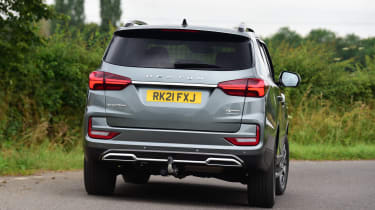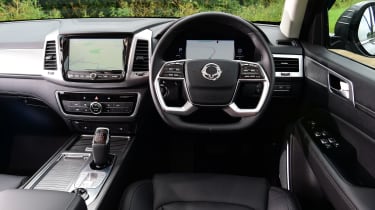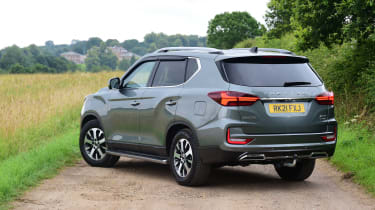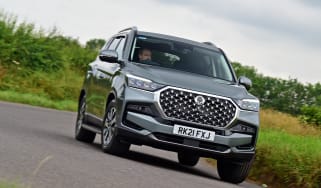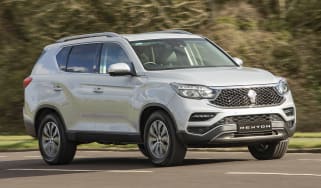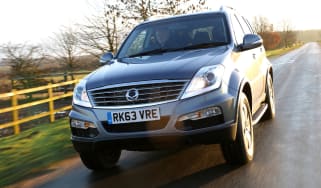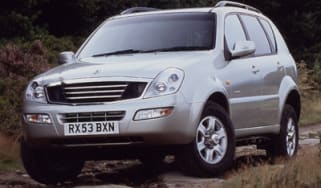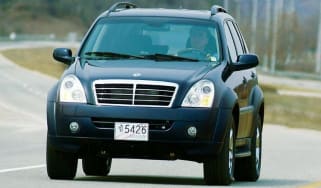SsangYong Rexton review
The SsangYong Rexton 4x4 is pitched as a bargain-priced Discovery – so does it deliver?
When the first SsangYong Rexton appeared on UK shores in 2003, it was notable for being very large and very cheap, but not a lot else. In the intervening years the company didn’t do much to improve things, while a glut of more modern and sophisticated SUVs appeared to highlight the Rexton’s predicament as a motoring dinosaur.
The Korean car maker’s regeneration has been in full swing for a while now, however, with models such as the Tivoli showing SsangYong has what it takes to go toe to toe with brands in Europe. Now it’s the turn of the facelifted Rexton, which is sporting a smart new look, fresh on-board tech and an increase in power.
The sharper appearance can’t disguise its sheer size, though – that bulky rear overhang is a consequence of it being 8cm longer and 12cm taller than a Hyundai Santa Fe.
SsangYong has made a few mechanical tweaks to the Rexton, but the one thing that hasn’t changed is its separate chassis construction; although this format is undeniably rugged, these days it’s typically reserved for commercial-based pick-ups and the like.
The Rexton includes two trim levels - Ventura and Ultimate. Standard kit is excellent, but the Ultimate model is packed to the rafters with a 9.2-inch touchscreen with sat-nav, Nappa leather upholstery, a powered tailgate an a 3D surround view camera.
Used - available now

2018 DS
3
33,030 milesManualPetrol1.2L
Cash £6,899
2023 Skoda
Kamiq
29,000 milesAutomaticPetrol1.5L
Cash £17,723
2022 Hyundai
Tucson
27,734 milesManualPetrol1.6L
Cash £17,654
2023 MINI
Cooper Electric
5,233 milesAutomaticElectric
Cash £14,287There’s also a full suite of active and autonomous safety tech, but as a result, the Rexton is no longer the bargain buy it once was. The Ultimate version is priced at just over £40,000, which puts it head-to-head with a top-spec Skoda Kodiaq.
All this kit doesn’t make the interior feel any posher, though; the design and quality are probably akin to a Mercedes ML-Class of a couple of generations ago. Still, if you want a genuinely tough machine for towing, or an off-road workhorse that can double up as convincing family transport, the Rexton ticks a lot of boxes.
Engines, performance and drive
Despite persisting with a body-on-frame construction – a design that you’ll only really see on pick-ups and dedicated off-roaders these days – SsangYong did at least manage to address some issues with the chassis set-up, and the Rexton is considerably stiffer, with far more high-strength steel used than in previous generations.
The downside of body-on-frame cars is that they rarely match the ride and handling standards set by the unibody construction of most modern SUVs - and the Rexton is no different.
SsangYong has introduced recalibrated steering with adjusted weighting to the refreshed model, plus tweaks to the springs and dampers and new wheels and tyres. Improvements to the driving dynamics are noticeable, but this is by no means front line technology.
The facelifted version benefits from tweaked suspension which has improved the ride a touch, but it still fidgets around at town and motorway speeds. New hydraulic engine mounts and better noise insulation means refinement is a step ahead of the previous car.
The steering is overly assisted, which is ideal for off-roading, but its vagueness takes a bit of getting used to on tarmac. Most of the time the ride is soft and well damped, while wind and road noise aren’t noticeable. But hit a sharp bump and shudders are still felt through the body and steering column.
Push hard through bends and the Rexton feels heavy with noticeable body roll, but again, it’s perfectly acceptable when driven with moderation.
As a result, for those after a rugged workhorse with enough comfort for the family, it strikes a decent balance between on-road composure and very effective off-road prowess. A locking centre differential and low-range ratios in the gearbox mean the Rexton will keep ploughing on when many more premium SUV rivals are floundering.
Engines, 0-60 acceleration and top speed
SsangYong only offers a single diesel engine option: the 2.2-litre E-XDI oil-burner now delivers 199bhp and 441Nm of torque, up from 179bhp and 420Nm, which is enough to give the Rexton acceptable performance.
The previous Mercedes-sourced seven-speed auto gearbox has been replaced by an eight-speed auto from Hyundai. It's an improvement; better at slower speeds and allowing smoother shifting when building up pace. The new set-up also has manual paddles mounted behind the steering wheel.
Either way, the Rexton doesn’t encourage being pushed, covering 0-62mph in 10.7 seconds, with a 115mph top speed.
MPG, CO2 and Running Costs
The Rexton is a big, heavy car, and its running costs – particularly fuel consumption – are much closer to a one-tonne pick-up truck than some of the lighter, but more fashionable SUVs on the market. That’s probably fair enough, given that the Rexton is arguably more likely to appeal to buyers considering a Mitsubishi L200-style double cab or Nissan Navara.
Official fuel economy stands at 32.9mpg on the combined cycle which, in a market dominated by efficient hybrid tech, just won't cut it against rivals. CO2 emissions of 225g/km are high, too, which will definitely put off any business users seeking cheaper Benefit-in-Kind tax rates.
The Rexton Ultimate versions are now priced at over £40,000, which means you even have to pay the road tax premium of £490 during years 2-6.
Insurance groups
The Rexton Ventura sits in insurance group 34, while top-spec Ultimate models are in group 35. In comparison, a 197bhp 2.0-litre diesel Skoda Kodiaq in top Laurin & Klement trim sits in group 27.
Depreciation
Once a byword for plummeting prices, SsangYong has proven, with the likes of the Tivoli, that it can produce cars whose desirability extends into the used market. Expert data suggests the Rexton will hold onto around 46% of its value over three years and 36,000 miles.
Interior, design and technology
The latest Rexton may not have the street cred or style of the new Land Rover Defender, but it still holds huge appeal as a tow car and may well entice those people who like to go off the beaten track and just fancy something a bit different.
It’s big and boxy as before, but the Rexton has a redesigned grille to help it feel just a little more upmarket. This is further complemented by the rakish headlamps with LED running lights, creating a more up-to-date look.
Jump inside and the first thing you’ll notice – apart from the impressive space on offer – is the attempt to address cabin quality. SsangYong has done its best to add soft-touch plastics and piano-black surfaces, but the plasticised chrome feels tacky.
Standard kit is generous, with Ultimate models featuring 18-inch alloy wheels, LED front fog and cornering lights, rear privacy glass, an electric tailgate, premium Nappa leather seats with heating and ventilation functions and a heated steering wheel.
Sat-nav, stereo and infotainment
The top-spec Rexton comes with a big 9.2-inch touchscreen featuring all the bells and whistles, while even entry-level EX models offer an eight-inch touchscreen with DAB radio and smartphone connectivity, as well as a reversing camera and MP3 playback. The instrument cluster scores on hi-tech appeal, too, with its various selectable functions and engaging start-up animation. Range-topping Ultimate versions add a 3D around view monitoring system and an 8.0-inch TFT driver information display.
Practicality, comfort and boot space
As you would expect from a car the size of the Rexton, there’s plenty of space inside, as well as a light and airy feel. It’s also pretty luxurious, with nappa leather upholstery, loads of adjustment for the front seats – powered of course – and plenty of creature comforts to boot. Visibility is excellent, but the sheer size of the Rexton may cause difficulties for some less-confident drivers.
Size
The Rexton measures 4,850mm from nose to tail, plus 1,960mm wide and 1,825mm high. That’s over 20cm longer and 10cm wider than a Nissan X-Trail.
Leg room, head room & passenger space
The Rexton is now only available as a seven-seater. Up front the driver and passenger have acres of space, while there’s loads of headroom for the second row and reasonable legroom. The third row of seats has a more spacious feel than you’ll find in a Skoda Kodiaq or Kia Sorento, although you have to fold down one of the chairs in the second row in order to to gain access.
Boot
Five-seat models benefit from a huge 820-litre boot, and if you want to fold the seats down it increases to a van-like 1,977 litres. There’s a false floor behind the seats which gives a fully flat load space from the tailgate across the folded second-row seats. With the third row of seats installed but folded down, you still get an impressive 649 litres of luggage space – and they live beneath the false floor when not in use.
Towing
With its heavy build and body-on-frame construction retained, the Rexton remains a very strong tow car. In fact it can mix it with the far pricier Land Rover Discovery, which also has a 3.5-tonne braked trailer limit, and the combination of low-ratio gears and four-wheel drive should make tricky off-tarmac towing tasks a breeze.
Reliability and safety
The Rexton range has won a decent reputation for reliability thanks to its somewhat agricultural engineering and relative simplicity. There’s a lot more hi-tech kit on the latest model, but the nuts and bolts beneath it should be as solid as ever. The latest engine is SsangYong’s own design, while the eight-speed auto gearbox is supplied by Hyundai, and also used by Genesis and Kia, so it should prove dependable.
Plenty of seven-seat SsangYongs have also found their way into taxi fleets in the past, which must speak volumes about the vehicles’ capacity to soak up miles.
The Rexton hasn’t been crash-tested by Euro NCAP, but it benefits from an extensive range of safety equipment, including active emergency braking, collision warning and lane departure warning – bolstered on top-spec versions by blind spot and cross traffic alerts. ELX and Ultimate models also add side airbags for rear seat passengers and a driver's knee airbag.
Warranty
SsangYong provides a 7 year/150,000 mile warranty for all of its vehicles. If you decide to sell your vehicle within the warranty period, the new owner will also benefit from the remaining cover.
Servicing
Rexton owners will need to book a service every year or 12,500 miles.


